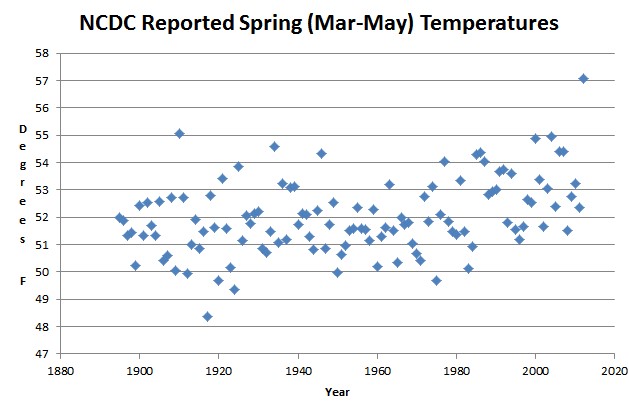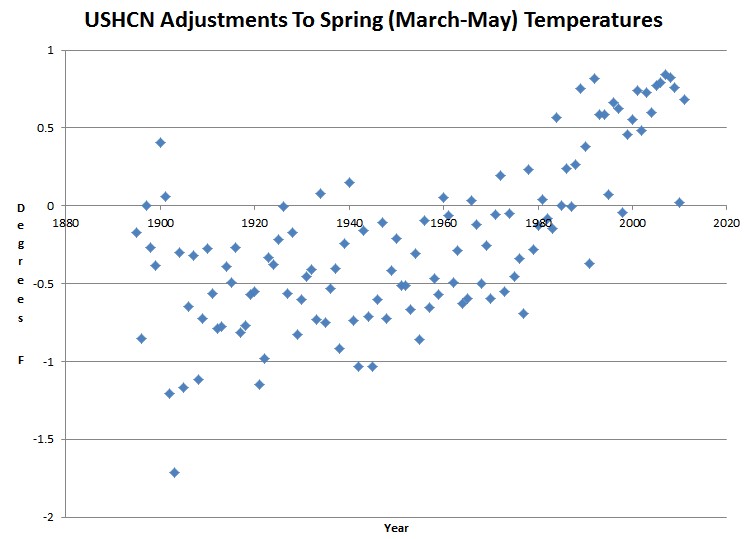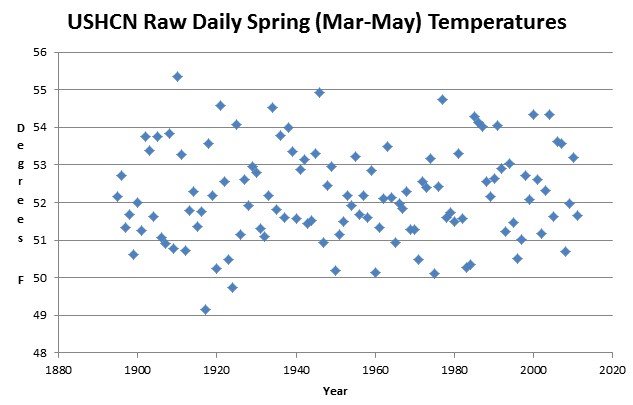A reader wrote :
This got me interested to see what USHCN was doing to springtime temperatures. The graph below is what NCDC reports.
So I calculated the adjustments they did through 2011 vs. the raw daily data. Stunning indeed! They added about two degrees on to recent temperatures relative to 100 years ago.
The spring of 1934 was probably just a warm as spring 2012, but the data has been so severely altered, that the NCDC graphs are meaningless garbage
The raw graph (calculated from daily data) is shown below. 2012 is not included because that data is not available yet.
Note the similarity between the adjustment graph, and Hansen’s temperature graph in the article below this one.
Raw data below :
Year Daily Raw NCDC Adjustment 1895 52.16933333 52 -0.169333333 1896 52.71106667 51.86 -0.851066667 1897 51.32856667 51.33 0.001433333 1898 51.68836667 51.42 -0.268366667 1899 50.62173333 50.24 -0.381733333 1900 52.01113333 52.42 0.408866667 1901 51.263 51.32 0.057 1902 53.75673333 52.55 -1.206733333 1903 53.3941 51.68 -1.7141 1904 51.63103333 51.33 -0.301033333 1905 53.7593 52.59 -1.1693 1906 51.07523333 50.43 -0.645233333 1907 50.89956667 50.58 -0.319566667 1908 53.82733333 52.71 -1.117333333 1909 50.78736667 50.06 -0.727366667 1910 55.3474 55.07 -0.2774 1911 53.26366667 52.7 -0.563666667 1912 50.71096667 49.92 -0.790966667 1913 51.78576667 51.01 -0.775766667 1914 52.3006 51.91 -0.3906 1915 51.35383333 50.86 -0.493833333 1916 51.74836667 51.48 -0.268366667 1917 49.16276667 48.35 -0.812766667 1918 53.56833333 52.8 -0.768333333 1919 52.1783 51.61 -0.5683 1920 50.24296667 49.69 -0.552966667 1921 54.57816667 53.43 -1.148166667 1922 52.5525 51.57 -0.9825 1923 50.47273333 50.14 -0.332733333 1924 49.72783333 49.35 -0.377833333 1925 54.07786667 53.86 -0.217866667 1926 51.1473 51.14 -0.0073 1927 52.6126 52.05 -0.5626 1928 51.92136667 51.75 -0.171366667 1929 52.94486667 52.12 -0.824866667 1930 52.81023333 52.21 -0.600233333 1931 51.30533333 50.85 -0.455333333 1932 51.0973 50.69 -0.4073 1933 52.18916667 51.46 -0.729166667 1934 54.5217 54.6 0.0783 1935 51.81783333 51.07 -0.747833333 1936 53.77023333 53.24 -0.530233333 1937 51.59523333 51.19 -0.405233333 1938 54.00566667 53.09 -0.915666667 1939 53.35303333 53.11 -0.243033333 1940 51.57216667 51.72 0.147833333 1941 52.88563333 52.15 -0.735633333 1942 53.13206667 52.1 -1.032066667 1943 51.45186667 51.29 -0.161866667 1944 51.50893333 50.8 -0.708933333 1945 53.29183333 52.26 -1.031833333 1946 54.91286667 54.31 -0.602866667 1947 50.94503333 50.84 -0.105033333 1948 52.44356667 51.72 -0.723566667 1949 52.9447 52.53 -0.4147 1950 50.1998 49.99 -0.2098 1951 51.1512 50.64 -0.5112 1952 51.4912 50.98 -0.5112 1953 52.17936667 51.51 -0.669366667 1954 51.9088 51.6 -0.3088 1955 53.211 52.35 -0.861 1956 51.67593333 51.58 -0.095933333 1957 52.18553333 51.53 -0.655533333 1958 51.59763333 51.13 -0.467633333 1959 52.86053333 52.29 -0.570533333 1960 50.13736667 50.19 0.052633333 1961 51.33943333 51.28 -0.059433333 1962 52.10013333 51.61 -0.490133333 1963 53.47796667 53.19 -0.287966667 1964 52.12756667 51.5 -0.627566667 1965 50.9459 50.35 -0.5959 1966 51.96773333 52 0.032266667 1967 51.85066667 51.73 -0.120666667 1968 52.29246667 51.79 -0.502466667 1969 51.2744 51.02 -0.2544 1970 51.27506667 50.68 -0.595066667 1971 50.4837 50.43 -0.0537 1972 52.5636 52.76 0.1964 1973 52.39073333 51.84 -0.550733333 1974 53.15883333 53.11 -0.048833333 1975 50.12253333 49.67 -0.452533333 1976 52.4377 52.1 -0.3377 1977 54.73486667 54.04 -0.694866667 1978 51.60426667 51.84 0.235733333 1979 51.74223333 51.46 -0.282233333 1980 51.49796667 51.37 -0.127966667 1981 53.30816667 53.35 0.041833333 1982 51.5623 51.48 -0.0823 1983 50.2756 50.13 -0.1456 1984 50.35533333 50.92 0.564666667 1985 54.29673333 54.3 0.003266667 1986 54.12783333 54.37 0.242166667 1987 54.02363333 54.02 -0.003633333 1988 52.56606667 52.83 0.263933333 1989 52.16696667 52.92 0.753033333 1990 52.6262 53.01 0.3838 1991 54.05136667 53.68 -0.371366667 1992 52.9149 53.73 0.8151 1993 51.21626667 51.8 0.583733333 1994 53.02523333 53.61 0.584766667 1995 51.45953333 51.53 0.070466667 1996 50.50443333 51.17 0.665566667 1997 51.0173 51.64 0.6227 1998 52.7064 52.66 -0.0464 1999 52.0749 52.53 0.4551 2000 54.3281 54.88 0.5519 2001 52.62233333 53.36 0.737666667 2002 51.1756 51.66 0.4844 2003 52.3108 53.04 0.7292 2004 54.35183333 54.95 0.598166667 2005 51.61603333 52.39 0.773966667 2006 53.61003333 54.4 0.789966667 2007 53.5653 54.41 0.8447 2008 50.6838 51.51 0.8262 2009 51.97833333 52.74 0.761666667 2010 53.19943333 53.22 0.020566667 2011 51.66026667 52.34 0.679733333






Woah! 0.37°F of warming in 2°F of adjustments? I’m dying of heat prostration here.
AGW… Alarmists Gone Wild!!!!!
Spring break may be over in Rio, but that does not mean that the party is over… watch as crazed ‘climate experts’ heat up the airwaves with hotter than ever predictions of a sizzling doomsday!
Has anyone tried to explain the justification for the adjustments? Or is it just blatant cheating?
Have not read anything about why the adjustments are made, but it does appear that the claim that adjustments in recent years are nearly always up and in years in the early part of the century, they are down. I think that looks kind of like blatant cheating…….
Stephen and readers,
All of the data, as well as a description of the corrections for known inhomogeneities, are available at the link below.
http://lwf.ncdc.noaa.gov/oa/climate/research/ushcn/ushcn.html#QUAL
The cumulative effect of the adjustments for Time of Observation Bias, MMTS/CRS bias, and
Urban Heat Island effects is a gradual 0.5F warming since around 1970. Earlier years have not been significantly affected by these adjustments. See the graphic of Raw USHCN – Adjusted USHCN here: http://lwf.ncdc.noaa.gov/img/climate/research/ushcn/ts.ushcn_anom25_diffs_urb-raw_pg.gif.
Time of Observation Bias was a correction to a known inhomogeneity caused by the earlier practice of setting the min/max thermometer in the late afternoon or evening. On days when, for instance, a cold front would pass or the following day would be cloudy and rainy, the high would be recorded as the set maximum from the previous day. The adjustment is rather small — only a few tenths of a degree — and based on sound science.
The correction for MMTS was due to the switch from cotton region shelters to MMTS. It was discovered that the MMTS sites had a slight cool bias compared to the the cotton region shelters. This correction is designed to eliminate the cooling bias imparted by the switch to MMTS, and again is based on sound, published scientific methods.
The correction for UHI is minimal, and is based on a regression analysis comparing sites affected by urbanization to nearby non-urban sites. This correction is minimal, and I believe generally a negative correction. For some sites that have moved from city centers to the outskirts of the city (most sites haven’t moved that much, but they may if it’s a data sparse region), the UHI correction may actually be slightly positive to correct for step changes associated with the site move. The overall effect, however, is minimal.
The net of these effects, again, is rather small. Only on the order of an effective warming of about 0.5F in recent years, and are only designed to eliminate KNOWN biases in the data set. For comparison, Spring 2012 was about two degrees warmer than the previous record. Even eliminating these adjustments, it would still be about 1.5 degrees warmer than the previous record. Moreover, the effect on the reported trend is probably only on the order of a couple tenths of a degree, out of a trend of about +1.2/century. Given the U.S. is only about 0.02% of the earth’s surface, these changes would affect the reported global trend to the extent of maybe a tiny fraction of a hundredth of a degree.
The “apparent” downward adjustment Stephen found in earlier years is because he merely took the average of all of the data points without correcting for geographic distribution. Obviously, if the geographic distribution of the sites has changed you have to adjust accordingly.
Hope this helps!
Complete BS.
You are looking at USHCN1 documentation which is now obsolete for a decade. The USHCN2 adjustments are about 3X that size..
USHCN stations tend to be fairly evenly distributed geographically, and the same patterns of adjustment are seen in the state by state data, which makes your point completely moot.
Computers are very efficient tools for generating large amounts of meaningless data. The fact that someone implemented some flaky algorithms in software is not particularly impressive
The 1.5 degree adjustments are larger than the claimed trend. which means a signal to noise ratio of less than one. That is what you call sound science? It is junk science at its worst.
The “apparent” downward adjustment Stephen found in earlier years is because he merely took the average of all of the data points without correcting for geographic distribution. Obviously, if the geographic distribution of the sites has changed you have to adjust accordingly.
This argument has been used before, but does not stand up under scrutiny, as this analysis in Alabama shows.
http://notalotofpeopleknowthat.wordpress.com/2012/06/08/ncdc-cooling-the-past-again/
Why is a “couple of tenths of a degree” insignificant when adjusting data but HUGE on those warming graphs? If .2 of a degree is not a big deal, why are all warming graphs done in .10 increments. Because it IS significant when you want it to be and not if you don’t.